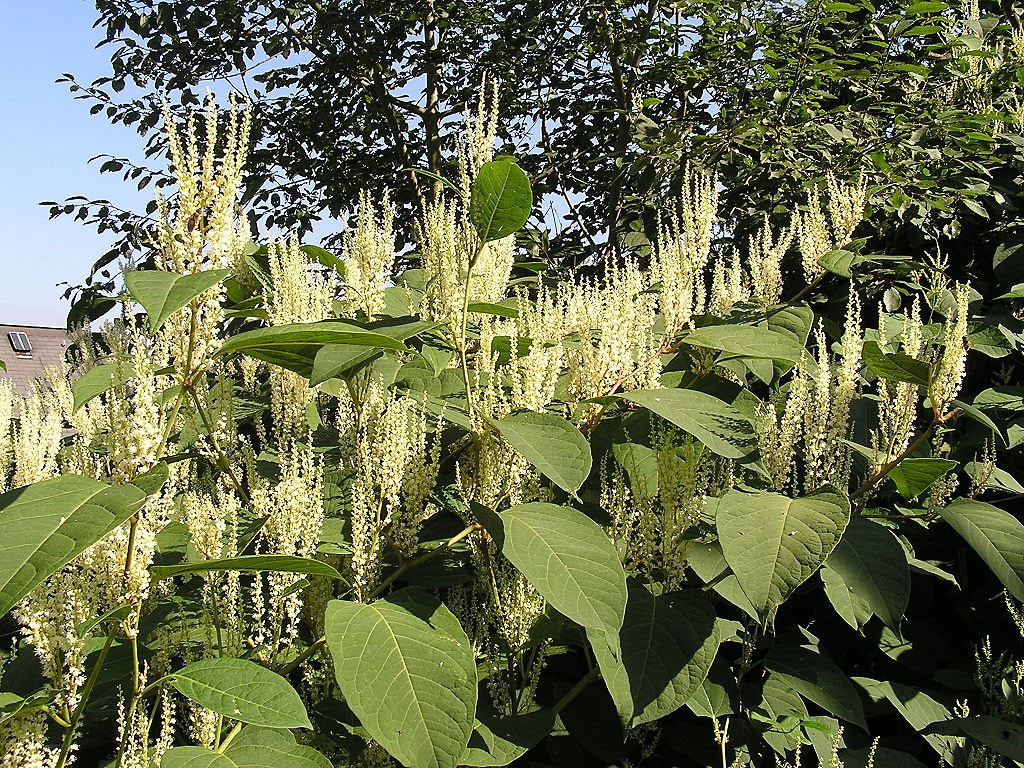Got knotweed? Now what?

One theory is that all the world’s knotweed is one plant with an unkillable rootball at the center of the earth. But don’t despair. Photo: MdE, Creative Commons, some rights reserved
Often termed “bamboo” because of its hollow jointed stems and impressive growth rate, Japanese knotweed (Fallopia japonica) is well-established in northern New York. As the name suggests, it’s from “away.” Native to Japan and Korea, it was imported to the United States in the late 1800s as an ornamental.
In its home range it grows in some of the least hospitable sites, including—reportedly—in pure volcanic ash. Compared to that, just about anywhere in our region is a paradise. In back yards and vacant lots, along utility and rail rights-of-way, and stream banks, this exotic plant thrives, forming dense thickets. Children love to play in these “forests,” but most adults aren’t keen on having to beat back the invader from their gardens and lawns. But because knotweed can provide instant privacy, some welcome it.
As invasive plants go, it could be worse. Knotweed doesn’t blister your skin like giant hogweed and wild parsnip do or stamp out forest regeneration in your woodlot the way swallow-wort does. It’s not poisonous to animals; in fact it’s grazed by deer, rabbits, and even livestock. Maybe the “best” part is that it produces little or no viable seed.
And it has some genuine good points. It is a source of resveratrol, a compound which shows promise in the treatment of cancer and heart disease. Its flowers, while unable to beget offspring, produce loads of nectar and pollen, and are an important late-season nectary (I’ve been waiting to use that word) for honeybees and wild pollinators. It’s also edible. The young shoots taste much like rhubarb and can even be made into pie.
Of course knotweed has many strikes against it or folks wouldn’t get so agitated when you mention its name. The major complaint is probably that it’s hard to eradicate. It spreads through its tough perennial roots–rhizomes–which may be unparalleled in their tenacity. You can smother knotweed for several years only to have it reappear like Houdini when you yank the covering back. Knotweed can be moved accidentally with soil or fill, as a teeny bit of rhizome is all it takes for trouble to start.
When I moved into my home the whole back side was engulfed by knotweed, as was most of the yard. For six years I mowed weekly, and by year seven it appeared I had triumphed. Then after a summer free of the weed, a number of knotweed shoots, wan and tentative though they were, arose the following spring. They’re gone now. Arduous as that may sound, I actually consider knotweed one of the easiest invasive plants to manage on dry ground. But in riparian habitats, i.e. along waterways, it is a true monster. Its superpower? A tiny fragment of stem, root, or leaf, so long as it stays moist, quickly becomes an impenetrable thicket.
Fluctuating water levels wash plant fragments downstream and create innumerable knotweed colonies. In some stretches of the Oswego and Salmon Rivers, the banks are literally walls of Japanese knotweed. It restricts—sometimes eliminates—water access, and out-competes existing vegetation. Because its tops die back each fall it does not mitigate erosion the way native shoreline plants like willow and shrub dogwood do, and water quality and habitat suffer.
As much as I’d rather avoid pesticides, I have to admit that with the right herbicide knotweed is as easy as, um, pie to kill. Glyphosate, the active ingredient in products like Roundup, is extremely effective when applied at the optimal time–early fall–and in the right concentration. Along shorelines, where killing knotweed is most essential, non-chemical methods are of limited use. Stem injection, the labor-intensive process of injecting each stalk with a small dose of concentrated glyphosate, is safe to use right up to the water’s edge and is very effective. Another riparian option is the cut-stem method, where stalks are cut and removed, and the “stumps” treated with glyphosate. Good old-fashioned foliar application can be employed a safe distance from surface waters.
So what about backyard knotweed? Non-chemical methods include repeated hand-pulling where practical, or mowing, and smothering.
If you choose herbicide, which application method is best? The St. Lawrence-Eastern Lake Ontario Partnership for Invasive Species Management just concluded a three-year knotweed eradication project on a section of the Salmon River near Pulaski, NY. They found after three years there was no measurable difference between the three methods. Given that a stem injector costs hundreds of dollars and foliar application goes at least ten times faster than the cut-stem method, the best option might be the equally effective but cheaper and easier one.
Please note that while it’s legal to treat knotweed on your own property, you must have a New York State Department of Environmental Conservation (NYS DEC) pesticide applicator license to do so anywhere else, even at your next-door neighbor’s or mom’s place. Just saying. And always follow label instructions.
For further—and accurate—information on knotweed go to www.sleloinvasives.org or contact your local Cornell Cooperative Extension office.
Paul Hetzler is a horticulture and natural resources educator with Cornell Cooperative Extension of St. Lawrence County.






.png)

And don’t get Roundup in water. The surfactant in it is not good for fish. There are other glyphosate formulations that are acceptable.
Cornell has a “roller crimper” for cover crop management. Has it been tried as a control for knottweed?